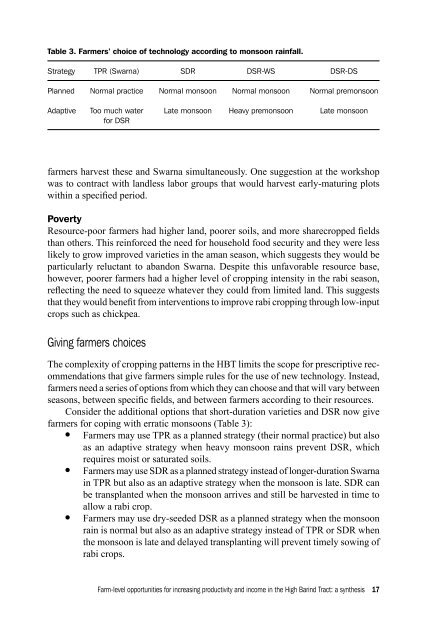Download (2461kB) - University of Greenwich
Download (2461kB) - University of Greenwich
Download (2461kB) - University of Greenwich
- No tags were found...
Create successful ePaper yourself
Turn your PDF publications into a flip-book with our unique Google optimized e-Paper software.
Table 3. Farmers’ choice <strong>of</strong> technology according to monsoon rainfall.Strategy TPR (Swarna) SDR DSR-WS DSR-DSPlanned Normal practice Normal monsoon Normal monsoon Normal premonsoonAdaptive Too much water Late monsoon Heavy premonsoon Late monsoonfor DSRfarmers harvest these and Swarna simultaneously. One suggestion at the workshopwas to contract with landless labor groups that would harvest early-maturing plotswithin a specified period.PovertyResource-poor farmers had higher land, poorer soils, and more sharecropped fieldsthan others. This reinforced the need for household food security and they were lesslikely to grow improved varieties in the aman season, which suggests they would beparticularly reluctant to abandon Swarna. Despite this unfavorable resource base,however, poorer farmers had a higher level <strong>of</strong> cropping intensity in the rabi season,reflecting the need to squeeze whatever they could from limited land. This suggeststhat they would benefit from interventions to improve rabi cropping through low-inputcrops such as chickpea.Giving farmers choicesThe complexity <strong>of</strong> cropping patterns in the HBT limits the scope for prescriptive recommendationsthat give farmers simple rules for the use <strong>of</strong> new technology. Instead,farmers need a series <strong>of</strong> options from which they can choose and that will vary betweenseasons, between specific fields, and between farmers according to their resources.Consider the additional options that short-duration varieties and DSR now givefarmers for coping with erratic monsoons (Table 3): Farmers may use TPR as a planned strategy (their normal practice) but alsoas an adaptive strategy when heavy monsoon rains prevent DSR, whichrequires moist or saturated soils. Farmers may use SDR as a planned strategy instead <strong>of</strong> longer-duration Swarnain TPR but also as an adaptive strategy when the monsoon is late. SDR canbe transplanted when the monsoon arrives and still be harvested in time toallow a rabi crop. Farmers may use dry-seeded DSR as a planned strategy when the monsoonrain is normal but also as an adaptive strategy instead <strong>of</strong> TPR or SDR whenthe monsoon is late and delayed transplanting will prevent timely sowing <strong>of</strong>rabi crops.Farm-level opportunities for increasing productivity and income in the High Barind Tract: a synthesis 17
















